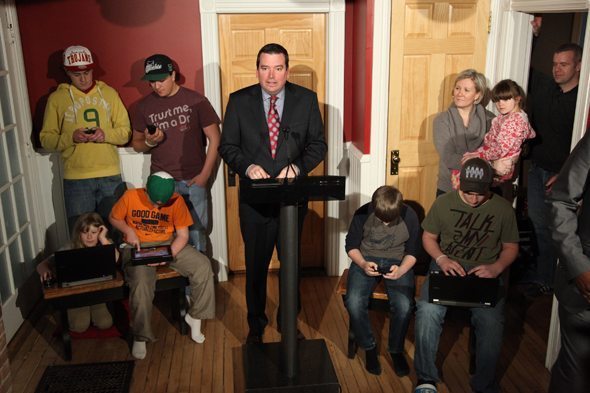The Canadian government’s plans to introduce competition into that country’s wireless space through stringent spectrum rules met with limited success as results from its auction of 700 MHz spectrum licenses were announced. The country’s three dominate players, Rogers Communications, Telus and Bell Canada, all gained spectrum licenses across most of the country, while most regions witnessed just one bidder outside the large three pick up a license.
Industry Canada, which conducted the auction, tried to put a positive spin on the outcome, proclaiming: “First and foremost, at least four wireless players in every region of the country now hold high-quality spectrum.”
In all, the auction included 108 rounds of bidding that ran from Jan. 14 though Feb. 13. A total of 97 licenses were awarded to eight companies participating in the proceedings, with total bids nearing $4.8 billion, which Industry Canada noted was the most generated by the country through a spectrum auction. Canada’s 2008 auction of licenses in the 1.7/2.1 GHz (AWS) band generated $4.25 billion in revenues.
The auction began with 10 eligible bidders, including Rogers, Bell and Telus, as well as a handful of smaller, regional players including Saskatchewan Telecommunications, MTS and Videotron. Other qualified bidders include Bragg Communications, Feenix Wireless, Novus Wireless and TBayTel.
Five initially qualified bidders dropped out before the proceedings started, including private equity group Catalyst Capital Group, BH Wave Acquisition Group, Vecima, 1770129 Alberta and Globalive.
Licenses up for bid included 12-megahertz paired blocks (blocks A, B, and C); 10-megahertz paired blocks (blocks C1 and C2); and six-megahertz unpaired blocks (blocks D and E).
Rogers forked over by far the largest amount on bids, putting up nearly $3 billion for 22 A-, B- and C-Block spectrum licenses covering nearly 33.4 million potential customers. Rogers picked up two licenses across most regions, giving it access to 24 megahertz of spectrum in the 700 MHz band.
Telus racked up just over $1 billion in total winning bids for 16 paired and 14 unpaired licenses covering nearly 33.5 million pops. The paired licenses included a mix of both 12-megahertz and 10-megahertz licenses.
Bell Canada spent nearly $511 million on 17 paired and 14 unpaired licenses covering nearly 33.5 million pops, with a similar mix of 12-megahertz and 10-megahertz paired licenses to that of Telus. Both Telus and Bell Canada operate with a network sharing arrangement allowing them to offer services in each other’s regions, with Bell Canada focused in Eastern Canada and Telus focused in Western Canada.
Of the non-nationwide operators participating in the auction, Quebec-based Videotron spent the largest sum, acquiring seven paired, 10-megahertz spectrum licenses for $210 million covering 28 million pops. Those licenses covered Quebec, as well as branching out into Ontario, Alberta and British Columbia.
Bragg, which offers services under the Eastlink brand, picked up four paired, 10-megahertz licenses covering 3.1 million pops across eastern provinces of Newfoundland, Labrador, Nova Scotia, Prince Edward Island, New Brunswick and Ontario for $18.3 million.
The remaining winners each picked up a single paired, 10-megahertz license focused in their home markets. MTS paid $7.9 million for a license covering 1.2 million pops in Manitoba; Sasktel paid $6.8 million for a license covering one million pops in Saskatchewan; and Feenix Wireless paid $256,000 for a license covering 107,215 pops in the Yukon, Northwest Territories and Nunavut. It should be noted that Feenix Wireless is reportedly backed by a former backer of beleaguered regional Canadian operator Mobilicity.
License rules will require companies that control two or more blocks of paired spectrum in the 700 MHz band to cover 90% of the country’s population with their “current high-speed coverage” within five years and 97% within seven years of being granted the licenses.
Industry Canada had initially looked at the 700 MHz auction as a way to infuse competition into the country’s wireless industry, including enacting rules limiting the amount of new spectrum incumbent operators could acquire. Those rules garnered jeers from the incumbents and others claiming they unfairly limited the ability for established players to get their hands on much-needed spectrum assets. Rogers’ CEO even questioned the country’s ability to support four nationwide operators, citing Canada’s population of 35 million people, or around the size of California.

Industry Canada’s Minister of Industry James Moore
In trumpeting the success of the ordeal, Industry Canada’s Minister of Industry James Moore noted: “The auction was a success because the rules were designed to put consumers front and center,” Moore said in a statement. “The summer of 2013 ignited a great deal of debate regarding our government’s wireless policy. Much of this debate has been filled with assumptions, speculation and misinformation about the outcome of this auction and the intent of our wireless policy. While this debate has played out among analysts and commentators, our government had one goal: to take deliberate, concrete steps to create more choice, lower prices, and better wireless service for Canadians and their families.”
Industry Canada could again look to bolster competition for the industry with its planned auction of 2.5 GHz spectrum scheduled for mid-2015.
Bored? Why not follow me on Twitter?


